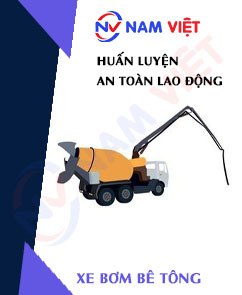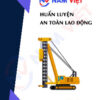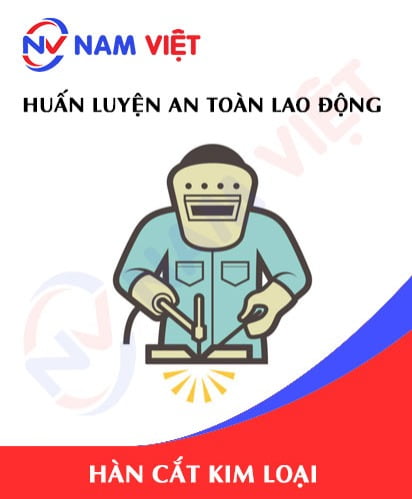Occupational Safety Training for Concrete Pump Truck Operation
99,000 ₫
Note: The above price is calculated for one person. Prices may vary depending on the number of trainees participating in the course and market fluctuations. For more accurate pricing information, please refer to the price list or contact our consultants directly.
Occupational safety is an important issue when operating a concrete pump truck and needs to be addressed promptly to ensure the health and safety of workers while also enhancing the reputation of businesses here. The Occupational Safety Training course is one of the effective solutions to raise awareness of accident prevention among workers when operating concrete pump trucks.
Table of Contents
Toggle1. Overview of Concrete Pump Trucks
a. What is a Concrete Pump Truck?
A concrete pump truck is a specialized vehicle used for transporting and pumping concrete.
Concrete pump trucks come in various types, classified based on boom length, pumping capacity, and boom type.
- Boom length: The boom length of a concrete pump truck can range from 20 meters to 70 meters.
- Pumping capacity: The pumping capacity of a concrete pump truck can range from 20 m3/h to 100 m3/h.
- Boom type: There are two main types of booms: straight boom and articulated boom.
Concrete pump trucks are widely used in construction projects, especially high-rise buildings and bridges. They help transport and pump concrete to the desired location quickly and efficiently, saving both time and construction costs.

b. Operating Principle of Concrete Pump Trucks
The concrete pumping system includes the following components:
- Piston pump: The piston pump is the most commonly used pump on concrete pump trucks. It works by using pistons to compress and push concrete out of the hopper.
- Screw pump: The screw pump is less commonly used on concrete pump trucks. It operates by using screws to move concrete out of the hopper.
- Engine: The engine provides power to the concrete pumping system.
Boom system
The boom system consists of the following parts:
- Boom: The boom is the main component of the boom system. It is used to deliver concrete to the desired pouring location.
- Pump head: The pump head is attached to the boom. It transfers concrete from the boom to the pouring location.
- Hand pump: The hand pump is used to pump concrete when the main pumping system is malfunctioning.
Operating principle
When the concrete pump truck operates, the engine provides power to the pumping system. The pump compresses and pushes the concrete out of the hopper. The concrete is then conveyed through the boom to the pump head, where it is delivered to the designated location.
Concrete pumping steps
The steps for pumping concrete include:
- Pour concrete into the hopper: Concrete is loaded into the hopper using a concrete mixer truck or other means.
- Start the concrete pump truck: The truck’s engine is started.
- Pump concrete: Operate the pump to move concrete from the hopper to the pump head.
- Deliver concrete to the desired location: The boom is controlled to place concrete at the required site.
- Pour concrete: Concrete is poured into the designated area.

c. Industries Using Concrete Pump Trucks
Concrete pump trucks are widely used in various industries, including:
- Construction industry: Most commonly used in construction, especially high-rise buildings and bridges. They help transport and place concrete efficiently, saving time and costs.
- Industrial sector: Used in factories to pump concrete into molds.
- Agricultural sector: Used for pumping concrete into irrigation works and rural infrastructure.
2. Overview of Safety Training for Operating Concrete Pump Trucks
a. What is labor safety training?
- Labor safety training for operating concrete pump trucks equips workers with knowledge on preventing workplace accidents. Workers who directly operate concrete pump trucks belong to Group 3.
- Safety training helps workers identify hazards and avoid risks, reducing the likelihood of workplace accidents.
REGISTER FOR LABOR SAFETY TRAINING SERVICE
b. Training duration
Initial safety training duration:
- Total training time is at least 24 hours, including exams.
- 8 hours of theory on safety and labor hygiene policies and regulations
- 8 hours of theory on basic safety and labor hygiene knowledge
- 4 hours of theory on specialized training content
- 2 hours of practical training on specialized content
- 2 hours of final theoretical exam
The safety training center may divide the schedule into multiple sessions depending on the workers’ availability. Typically, there are 6 sessions over 3 days if the company can arrange consecutive training hours.
Periodic safety training duration:
- Before the labor safety card expires, workers must complete a periodic safety training with at least 50% of the initial training duration.
Explanation: The total duration of periodic safety training is at least 12 hours, including exams. After successfully completing the training and passing the exam, workers will have their labor safety card renewed.
c. Training content
| No. | TRAINING CONTENT | TRAINING DURATION (HOURS) | |||
| Total | Including | ||||
| Theory | Practice | Exam | |||
| I | Safety and labor hygiene policies and regulations | 8 | 8 | 0 | 0 |
| 1 | Overview of legal documents on labor safety and hygiene. | 6 | 6 | ||
| 2 | System of technical safety and hygiene standards. | 1 | 1 | ||
| 3 | Specific regulations by state authorities regarding construction, expansion, or renovation of facilities, machinery, equipment, and materials with strict safety and hygiene requirements. | 1 | 1 | ||
| II | Basic safety and labor hygiene knowledge | 8 | 8 | 0 | 0 |
| 1 | Basic knowledge of hazardous and harmful factors at the workplace. | 4 | 4 | ||
| 2 | Methods to improve working conditions. | 1 | 1 | ||
| 3 | Safety culture in production and business. | 1 | 1 | ||
| 4 | Rights and responsibilities of employers and employees; safety policies and roles of safety officers. | 1 | 1 | ||
| 5 | Safety regulations, signage, use of safety equipment and PPE; first aid skills, occupational disease prevention. | 1 | 1 | ||
| III | Specialized training content | 6 | 4 | 2 | 0 |
| Comprehensive knowledge of machinery, equipment, hazardous materials; risk assessment and safe working procedures with machines and hazardous materials. | 6 | 4 | 2 | ||
| IV | Final safety training exam | 2 | 2 | 0 | 0 |
| Total | 24 | 22 | 2 | ||
See more training content for 6 groups
d. Labor safety card
After completing the training and passing the exam, workers will be issued a labor safety card (commonly known as the Group 3 safety certificate).
The Group 3 card shows personal information such as name, date of birth, job, and work environment. It also includes training duration, red stamp, and signature confirming completion.
According to regulations in Clause 2 of Article 24 of Decree 44/2016/ND-CP, there are two cases:
- If the worker has an employment contract with the employer, the employer must sign, stamp, and validate the card after training and passing the exam.
- If the worker is freelance or seasonal without a contract, the training unit must sign, stamp, and validate the card after the worker completes the training and passes the exam.

Group 3 labor safety card for operating concrete pump trucks
3. Hazards When Operating Concrete Pump Trucks
Concrete pump trucks are large, specialized vehicles that can pose many hazards if not operated properly. Here are some common hazards when operating concrete pump trucks:
- Traffic accidents: Concrete pump trucks are large trucks that can be dangerous when on the road. Common causes of traffic accidents involving concrete pump trucks include:
- Driver fatigue or lack of focus
- Speeding or exceeding the allowed speed limit
- Failure to comply with traffic regulations
- Adverse weather conditions
- Driver injuries: Drivers of concrete pump trucks are at higher risk of injury compared to drivers of other vehicles. Common causes of driver injuries include:
- Traffic accidents
- Occupational accidents
- Occupational diseases
- Damage to goods: Cargo on concrete pump trucks may be damaged due to collisions, vibrations, or environmental factors.
- Environmental pollution: Concrete pump trucks are a source of emissions, noise, and waste.

4. Measures to Prevent Occupational Accidents When Operating Concrete Pump Trucks
Occupational accidents when operating concrete pump trucks are serious issues that can cause injury or death to drivers and those around them. To prevent such accidents, the following measures should be implemented:
- Training and instruction: Concrete pump truck drivers must be properly trained in safe vehicle operation. Training should include knowledge and skills on:
- Traffic safety rules
- Safe driving skills
- Vehicle inspection and maintenance
- Use of personal protective equipment (PPE)
- Vehicle inspection and maintenance: Concrete pump trucks must be regularly inspected and maintained to ensure safe operation.
- Compliance with safety rules: Drivers must adhere to safety rules, including:
- Driving within allowed speed limits
- No alcohol or stimulants while driving
- Adequate rest before driving
- Use of safety equipment while driving
- Creating a safe working environment: Employers should create a safe working environment for drivers, including:
- Ensuring trucks are equipped with all necessary safety devices
- Providing drivers with adequate personal protective equipment (PPE)
- Inspecting and mitigating potential hazards that may cause occupational accidents
- Periodic inspection of concrete pump trucks helps detect safety issues such as wear, damage, or mechanical failures early, reducing the risk of occupational accidents.
5. Benefits of Occupational Safety Training
An Toàn Nam Việt provides your business with the following benefits after completing occupational safety training courses in accordance with Decree 44/2016/ND-CP on Occupational Safety and Hygiene for companies and enterprises:
- Employees can identify potential hazards and take preventive measures to avoid occupational accidents.
- Your business can establish risk prevention measures in production, operation, and maintenance processes.
- Minimizes costs associated with safety risks.
- Ensures uninterrupted production, increasing productivity and product quality.
- Compliance with labor safety regulations, avoiding legal risks.
- Enhances credibility and professionalism, boosting your company’s brand image.
Nam Việt’s training courses help individuals prevent external hazards, reducing the risk of injury or death.
REGISTER FOR OCCUPATIONAL SAFETY TRAINING SERVICES
6. Customer Feedback After Completing Training
An Toàn Nam Việt has many years of experience supporting businesses across Vietnam, especially in the southern provinces. Our commitment is invaluable, and therefore, our occupational safety training is continuously improving in professionalism. Our growth is fueled by positive feedback and constructive input from businesses. Below are some testimonials from partners we have served.
See more customer interviews after using services by An Toàn Nam Việt
7. Occupational Safety Training Competency of An Toàn Nam Việt
An Toàn Nam Việt is a reputable center for occupational safety training in Vietnam. Training sessions are conducted continuously at factories, production sites, or construction sites nationwide (63 provinces in Vietnam).
REGISTER FOR OCCUPATIONAL SAFETY TRAINING SERVICES
License for occupational safety training
- An Toàn Nam Việt has been inspected and certified by the Department of Safety, Ministry of Labor, Invalids, and Social Affairs, confirming our qualifications for occupational safety and hygiene training.

Materials and lectures
- All training materials for safety training courses are reviewed and approved to ensure accuracy and effectiveness.
- Lecturers follow teaching methods standardized by An Toàn Nam Việt, developed by experts in occupational safety and hygiene to maximize knowledge absorption.
Facilities
- Controlling classroom factors enhances teaching efficiency and knowledge retention.
- Our training facilities provide spacious classrooms with standard lighting and training equipment.
8. Nationwide Reputable Safety Training Center
At An Toàn Nam Việt, we prioritize the professionalism of occupational safety training. Our mission is to equip workers with knowledge to protect themselves, contributing to nation-building.
We carefully prepare every detail, from teaching tools and equipment to curricula, documents, sound, and lighting.
Our safety training instructors are experienced professionals, some with research in hazard identification across industries. Lectures are practical, vivid, and aligned with Decree 44/2016/ND-CP, ensuring effective learning.
This enables employees to apply hazard prevention measures in real work situations.
Our training center is proud to offer professional and reliable occupational safety training with advantages including:
- Competitive costs without compromising quality
- Flexible training schedules to fit company operations
- Quick, lawful certification procedures
- Experienced instructors
- Controlled classroom environment for better learning
- Lectures tailored to workplace safety
- Dedicated, professional customer support

9. Additional Occupational Safety Training Resources
- Safety materials for operating concrete pump trucks
- Occupational safety training materials set
- Occupational safety training test set
- Multiple-choice test on safety when operating concrete pump trucks
- Slides for occupational safety training for concrete pump trucks
1 review for Occupational Safety Training for Concrete Pump Truck Operation
No comments yet















phanminhhang341
The lecturer teaches very lively and easy to understand!